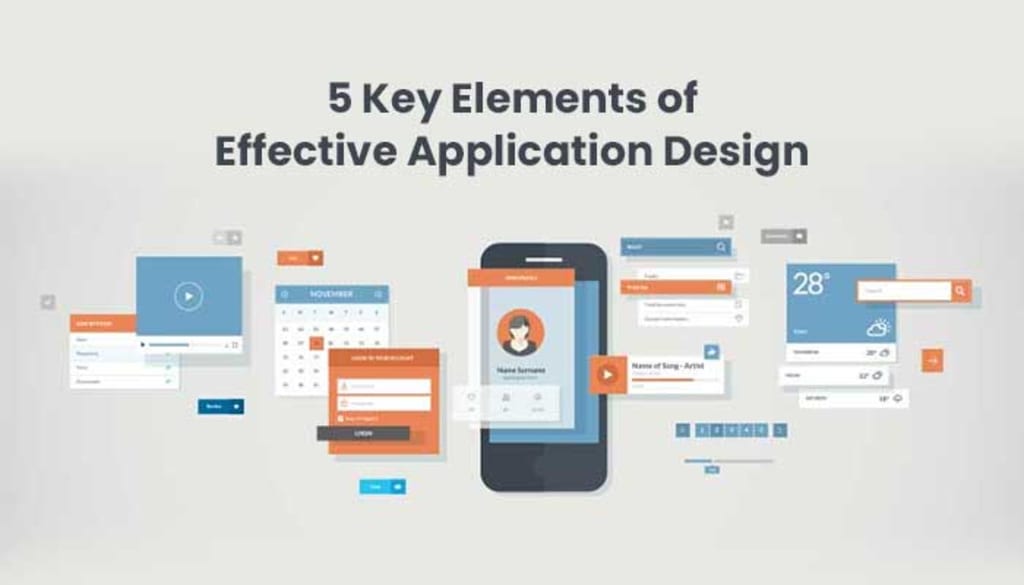5 Key Elements of Effective Application Design
Elements of Effective Application Design

In today's digital age, applications have become an integral part of our daily lives. From ordering food to managing our finances, applications make it easy for us to access the information and services we need. However, not all applications are created equal.
Effective Application Design is crucial for creating a user-friendly and efficient experience. In this blog post, we will discuss the 5 key elements of effective application design and how they can help create a seamless and satisfying user experience. We will cover topics such as user-centered design, simplicity, and navigation.
By understanding these key elements, you can ensure that your application is user-friendly, efficient, and enjoyable to use. So, let's dive in and explore the world of effective application design!
1. User-Centered Design
User-centered design is a design philosophy that focuses on creating products and services that meet the needs and expectations of the users. It is a user-centered approach to design that puts the user at the center of the design process and is built around their needs, goals, and preferences.
One of the key benefits of user-centered design is that it improves the user experience. By understanding the user's needs and goals, designers can create products and services that are easy to use and understand which in turn leads to increased satisfaction and engagement.
To implement user-centered design Mobile App Design Services, there are several key tips to keep in mind:
•Conduct user research to understand the needs and goals of your target audience
•Create user personas to represent the different types of users who will be using your application
•Test your designs with real users to get feedback and make adjustments
•Continuously iterate and improve your design based on user feedback
•Ensure that the design is accessible to all users, including those with disabilities.
2. Navigation:-
Navigation is a crucial aspect of application design as it helps users navigate through the app and find the information they need. It is the process of providing a clear and easy-to-use interface for users to access different sections of an application.
Clear and easy navigation is important because it helps users find what they are looking for quickly and efficiently. A confusing or difficult-to-use navigation system can lead to frustration and ultimately result in users abandoning the application.
When designing effective navigation in applications, it is important to keep the following tips in mind:
•Keep it simple: A simple and intuitive navigation system is easier for users to understand and use.
•Use clear labels: Use clear and descriptive labels for each section of the app to make it easy for users to understand where they are and where they need to go.
•Group similar items together: Grouping similar items together makes it easier for users to find what they are looking for.
•Test with users: Conduct user testing to see how they interact with the navigation system and make any necessary changes.
3. Visual Design:-
Visual design refers to the use of visual elements such as color, typography, layout, and imagery to create an aesthetically pleasing and user-friendly interface for applications. It plays a crucial role in creating an engaging user experience by providing a sense of hierarchy, organization, and consistency in the design.
When it comes to application design, visual design is essential for creating a seamless user experience. It can be used to guide the user through the interface, making it easy to navigate and understand.
Additionally, visual design can be used to convey the brand identity and message of the application, making it more memorable and impactful.
Here are some tips for implementing effective visual design in applications:
•Start with a clear design hierarchy: Use visual cues such as size, color, and typography to guide the user's eye through the interface and prioritize important information.
•Use consistent design elements: Consistency in design elements such as typography, color, and layout can help to create a cohesive and polished look for the application.
•Consider the user's experience: Always keep the user's experience in mind when designing the application. Use visual design elements that are easy to understand and navigate, and keep the interface simple and clean.
•Use high-quality imagery: Using high-quality imagery can add a sense of professionalism and credibility to the application. Additionally, it can be used to help convey the brand identity and message of the application.
4. Responsiveness:-
Responsiveness in application design refers to the ability of an application to adapt to different devices and screen sizes, providing an optimal user experience regardless of the device being used. This is achieved through the use of responsive design techniques, such as flexible layouts and media queries.
The importance of responsive design cannot be overstated, as more and more users are accessing applications on a variety of devices and screen sizes. A responsive design ensures that users are able to access and use the application easily and efficiently, regardless of whether they are using a desktop computer, tablet, or smartphone.
To design responsive applications, there are several tips to keep in mind:
•Use a flexible layout that can adapt to different screen sizes and orientations
•Utilize media queries to adjust the layout and design elements based on the device being used
•Test the application on different devices and screen sizes to ensure optimal performance
•Keep in mind the user experience when designing for mobile devices, as navigation and interactivity may need to be adjusted for smaller screens.
5. Accessibility
Accessibility in application design refers to the practice of making sure that all users, including those with disabilities, can access and use the application. This includes making sure that the application is easy to navigate, has clear and concise text, and is compatible with assistive technology such as screen readers.
The importance of accessibility for users with disabilities cannot be overstated. Many individuals with disabilities rely on technology to help them navigate and perform daily tasks, and without accessibility, these individuals may be excluded from using certain applications.
In addition, accessibility is not just important for individuals with disabilities, but for all users, as it can improve the overall usability and user experience of the application.
When designing accessible applications, there are several key points to keep in mind:
•Make sure that all text and images have alternative text for screen readers
•Incorporate keyboard navigation and shortcuts
•Ensure that the color contrast is high enough for users with visual impairments
•Provide options for users to adjust font size and layout
Conclusion
Effective application design is essential for creating user-friendly and engaging apps that are easy to navigate and use. The five key elements of effective application design include user-centered design, intuitive navigation, clear and consistent visual design, performance and scalability, and accessibility.
By understanding and implementing these elements in your app design, you can create an app that is not only visually appealing but also functional and easy to use. Remember, the key to a successful app is to keep the user in mind throughout the design process and to continuously test and iterate your design to ensure it meets the needs of your target audience.
About the Creator
Sprink Digital
Sprink Digital is a full-service online Digital Marketing Agency and primarily committed to the arena of Digital marketing exclusively.
Enjoyed the story? Support the Creator.
Subscribe for free to receive all their stories in your feed. You could also pledge your support or give them a one-off tip, letting them know you appreciate their work.






Comments
There are no comments for this story
Be the first to respond and start the conversation.